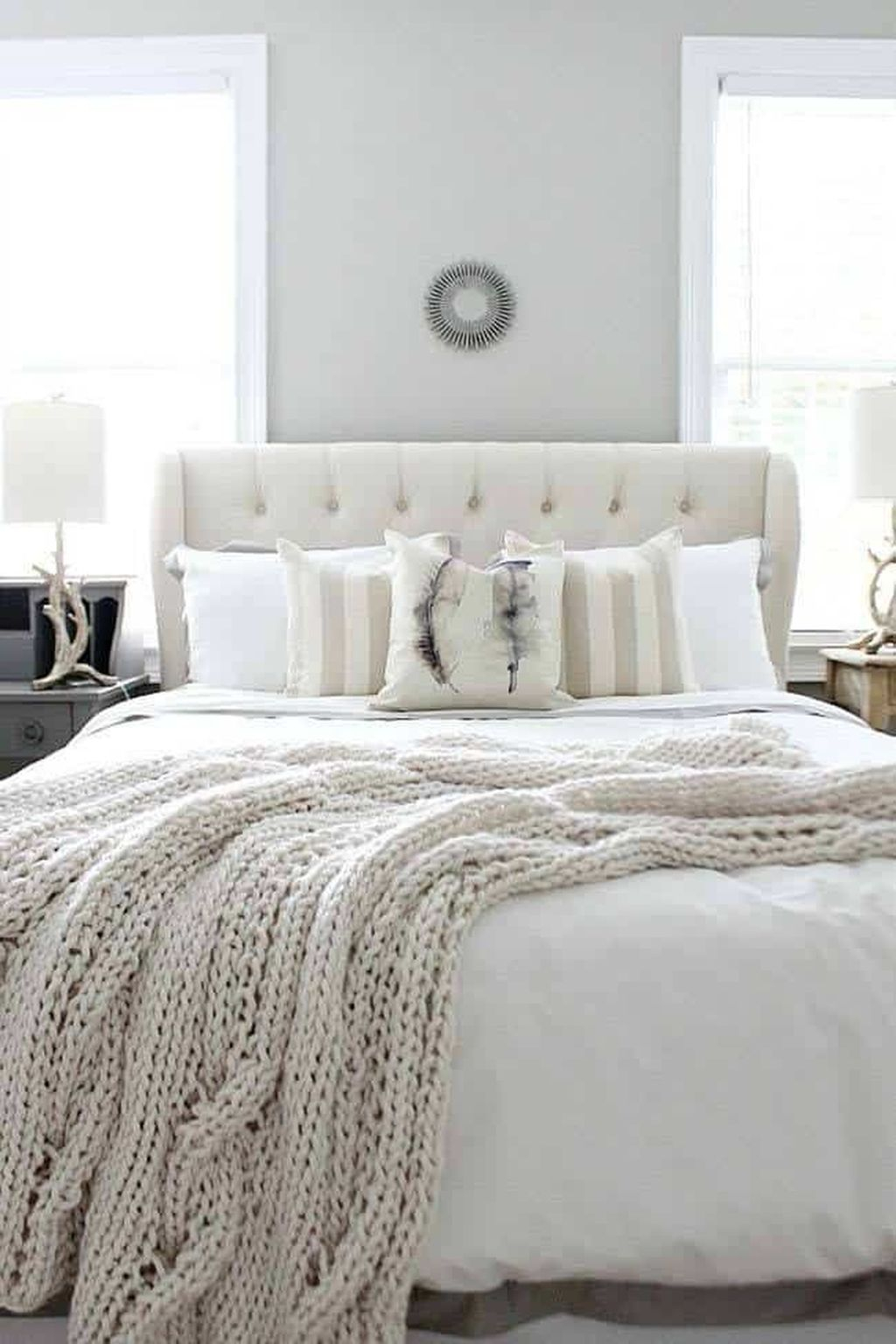Tired of bedrooms that feel too loud? Neutral tones offer a calming canvas for self-expression, allowing you to design a space that truly reflects your style. From minimalist chic to cozy bohemian, discover the transformative power of neutrals.
Creating Your Tranquil Retreat with Neutral Colors
Bold colors can sometimes feel overwhelming, especially in a space designed for relaxation. Neutrals offer a soothing alternative, transforming your bedroom into a peaceful sanctuary. They provide a calming backdrop, allowing you to unwind and recharge.
Exploring the Nuances of Neutrals
Neutrals encompass a wider spectrum than just beige and white. They are colors that don’t demand attention, acting as a subtle backdrop. Their underlying warm or cool tones can significantly influence the atmosphere of your room.
- Bright/Cool: Think crisp whites, creamy walls, and hints of pale yellow or green. These create an airy and spacious feel, ideal for smaller rooms.
- Muted: Soft, understated shades like off-white, beige, and light gray bring a sense of effortless elegance, like a gentle whisper.
- Dark/Warm: Deep grays, rich browns, golds, and taupes foster a cozy, intimate atmosphere, reminiscent of a comforting cabin retreat.
Designing Your Neutral Haven
Here’s how to utilize these colors to create a bedroom that’s both stylish and serene:
Playing with the Palette:
- Monochromatic Magic: Utilizing varying shades of a single neutral color adds depth and prevents monotony. Imagine light gray walls, charcoal bedding, and a rug in a mid-tone gray. Incorporating diverse textures, such as chunky knit blankets and sleek metal accents, further enhances the visual interest.
- Neutral Mixology: Harmoniously blend different neutrals. A popular combination is beige walls with crisp white bedding and warm brown accents in furniture or accessories. The key is to achieve a balanced and cohesive look.
Texture is Key:
Neutrals thrive on texture. It adds visual depth and prevents the room from feeling one-dimensional.
- Textiles to the Rescue: Introduce cozy sheepskin rugs, woven jute baskets, breezy linen bedding, or a luxurious velvet throw. These elements add layers of warmth and personality.
- Mix and Match Materials: Experiment with wood for natural warmth, metal for sleekness, and stone for grounding accents. Consider a marble bookend or a vase filled with river rocks.
- Layer It Up: Layering textures creates a rich tactile experience. Consider a smooth leather headboard against a rough-hewn wooden bench, or a fluffy shag rug next to a woven basket.
Infusing Your Personal Touch
Neutral doesn’t have to be impersonal. Here’s how to make your space truly your own:
- A Touch of Color: Introduce pops of color through throw pillows, vibrant artwork, or fresh flowers. Choose colors that complement your neutrals, not overpower them.
- Statement Pieces: A dramatic headboard, an eye-catching piece of art, or a sculptural light fixture can become a focal point in a neutral room.
- Functional Decor: Decorative items that also serve a purpose, such as woven storage baskets or floating shelves, add both style and practicality.
Expert Tips and Tricks
- Mirrors: Strategically placed mirrors reflect light and create the illusion of more space.
- Less is More: Embrace minimalism by choosing each piece intentionally.
- Nature’s Touch: Incorporate plants, wood accents, or natural elements to bring the outdoors in.
Designing a neutral bedroom is about creating a space that’s both stylish and serene. By embracing a calming color palette, layering textures, and adding personal touches, you can transform your bedroom into a haven that reflects your unique style. If you’re drawn to a moody bedroom, explore our guide on achieving that look. For further inspiration with neutral tones, our guide on neutral bedroom schemes is a great resource.
Are Neutral Colors Good for a Bedroom? Unveiling the Power of Tranquility
Neutral colors, including soft whites, calming creams, gentle grays, and warm beiges, offer significant advantages for creating a restful and stylish bedroom. They may contribute to better sleep and offer versatile design options.
One of the primary benefits of neutrals is their calming effect. Imagine being surrounded by soothing shades of dove gray or creamy off-white. This tranquil atmosphere can likely reduce stress and anxiety, promoting better sleep. Some research suggests that cooler neutrals, like blues and grays, may lower blood pressure and enhance relaxation. While research is ongoing, a connection between environment and sleep quality is likely, with neutrals potentially playing a positive role.
Similar to the serene atmosphere of a spa, incorporating these calming tones in your bedroom can create a personal sanctuary. This calming effect is especially beneficial in bedrooms, intended for rest and rejuvenation.
Beyond relaxation, neutrals are remarkably versatile and timeless. Unlike bolder colors that can quickly feel dated, neutrals offer a classic aesthetic that endures. This reduces the need for frequent redecorating. Neutrals also serve as an excellent backdrop for other design elements. They provide a blank canvas for incorporating pops of color through accessories, allowing for easy updates.
Think of neutrals as the foundation of a well-dressed room. They provide a solid base that can be accessorized with various colors and patterns to suit your preferences and current trends. This adaptability makes neutral bedrooms a smart long-term investment.
Here are some popular neutrals and the ambiance they create:
| Color | Vibe |
|---|---|
| White | Clean, Crisp, Airy |
| Cream | Warm, Cozy, Inviting |
| Gray | Sophisticated, Calm, Modern |
| Beige | Earthy, Natural, Relaxed |
| Greige | (Gray + Beige) Balanced, Versatile, Warm |
While individual preferences vary, neutral colors are a strong contender for bedroom design. They offer a unique combination of tranquility, timelessness, and versatility, making them a popular choice for a relaxing and stylish sleep space.
Designing a Neutral Bedroom: A Step-by-Step Guide
Let’s explore how to create a calming and stylish bedroom sanctuary using the power of neutrals. “Neutrals” encompasses a broad range of colors, including warm whites like ivory, cool whites with gray undertones, soft beiges, sophisticated grays, and rich browns. Each shade brings a unique vibe. Crisp white can make a small room feel larger, while warm gray creates coziness.
One theory suggests that neutral colors in the bedroom may improve sleep quality by promoting relaxation and calm. Research in this area is ongoing, with some experts believing the impact of color on sleep is complex, potentially related to how our brains process color and its effect on hormones. Incorporating neutrals in the bedroom may be worth exploring for better sleep.
The magic of decorating with neutrals lies in layering. Imagine a bed with plain white sheets. Now, add a textured off-white blanket, beige pillows with varying patterns, and a soft gray throw. The room instantly becomes more inviting. This principle applies throughout the room. Combining shades of the same neutral – a light taupe wall, slightly darker taupe curtains, and a rug with flecks of both – creates a subtle visual dynamic. Mixing textures, likechunky knit blankets, smooth linen sheets, woven baskets, and a plush velvet armchair, adds a rich tactile dimension.
Neutrals provide a blank canvas for various styles. Create a minimalist space with clean lines, simple furniture, and minimal decorations. Achieve a cozy Scandinavian vibe with light wood and textured textiles. A bohemian look can be achieved with earthy neutrals, natural materials, and layered textiles.
Don’t shy away from adding touches of color! A neutral backdrop showcases your personal style. Colorful throw pillows, vibrant artwork, a rug, or even plants can add life to a neutral room. It’s about finding the right balance. Subtle pastel hues offer a gentle touch, while saturated tones make a bolder statement.
Here’s a table with some ideas:
| Neutral Palette | Accent Colors | Style Inspiration | Textures & Materials |
|---|---|---|---|
| Whites, creams, light grays | Soft pastels, light blues, pale yellows | Minimalist, Scandinavian | Linen, cotton, wood, metal |
| Beiges, taupes, warm grays | Dusty rose, deep teal, burnt orange | Bohemian, Rustic | Wool, velvet, rattan, leather |
| Deep grays, charcoals, browns | Mustard yellow, emerald green, rich burgundy | Modern, Industrial | Concrete, metal, wood, faux fur |
When decorating with neutrals, less is often more. Each piece should contribute to the overall ambiance. Natural elements, like plants, wood, or stone, enhance tranquility. There’s no single “right” way to decorate with neutrals. Create a space you love.
Adding Color to a Neutral Bedroom: A Designer’s Guide
A neutral bedroom, with its calming shades of white, beige, gray, or greige, offers a perfect canvas. But how do you add personality without disrupting the tranquility? Adding color to a neutral bedroom enhances its inherent serenity. Here’s how:
1. The Accent Wall:
An accent wall acts as a focal point, adding depth and visual interest. Imagine a rich teal wall in a room painted creamy white. It draws the eye and expands the space. Consider wallpaper with a subtle pattern, or textured materials like wood or stone. This single element can dramatically shift the room’s feel.
2. Textiles: A Symphony of Color and Texture:
Textiles are a powerful tool for introducing color without permanent changes. Bedding is a great starting point. A duvet cover and pillowcases in deep ochre or cheerful coral brighten the space. Layer throws and blankets in contrasting colors and textures – an emerald green knit throw or a blush pink faux fur blanket. A patterned rug with pops of color grounds the room. The ease of swapping textiles allows for seasonal updates.
3. Artwork and Accessories: Your Personal Signature:
Artwork and accessories are key to injecting personality. A large painting with vibrant hues, a collection of colorful prints, or a striking sculpture can serve as a focal point. Consider decorative objects like vases, lamps, and bowls in complementary colors. Even small details like colorful candles or books add a personal touch.
4. Bringing Nature In:
Plants add a breath of fresh air and subtle color. Leafy ferns, flowering plants, or succulents liven up a neutral space. They also offer air-purifying benefits. Varying the sizes and types of plants adds visual interest.
5. Lighting: Enhancing Color with Ambiance:
Lighting plays a crucial role in color perception. Lamps with colored shades or warm-toned bulbs can highlight colorful accents and create various moods.
Navigating the Nuances of Color:
Adding color doesn’t mean creating a rainbow effect. Balance is key. Start small and gradually introduce more color until you achieve the desired result. There are no strict rules; trust your instincts. Some designers suggest a palette of two or three complementary colors, using various shades and tints. Others recommend the 60-30-10 rule: 60% dominant neutral, 30% secondary color, and 10% accent color.
| Element | Color Ideas |
|---|---|
| Accent Wall | Deep teal, rich ochre, warm terracotta |
| Bedding | Coral, sage green, dusty rose |
| Throws/Blankets | Emerald green, blush pink, navy blue |
| Rugs | Patterned with pops of color |
| Artwork | Vibrant hues, complementary colors |
| Accessories | Jewel tones, metallic accents |
| Plants | Varying shades of green, flowering plants |
Ongoing research in color psychology suggests that colors evoke specific feelings. Individual responses to color vary. Choose colors that create a space that you find comfortable and enjoyable.
- Burning Plastic Smell in House: Causes, Solutions, and Safety Measures - April 8, 2025
- Best Bug Killer for Yard: Effective Pest Control Guide (2024) - April 8, 2025
- Brown Recluse Spider Bites: Identification, Treatment, and Prevention - April 8, 2025










